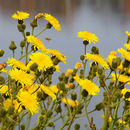Associations
provided by BioImages, the virtual fieldguide, UK
Foodplant / parasite
telium of Coleosporium tussilaginis parasitises live Sonchus palustris
Foodplant / internal feeder
larva of Ensina sonchi feeds within capitulum of Sonchus palustris
Remarks: Other: uncertain
In Great Britain and/or Ireland:
Foodplant / parasite
Golovinomyces cichoracearum parasitises live Sonchus palustris
Foodplant / parasite
uredinoid, amphigenous aecium of Miyagia pseudosphaeria parasitises live leaf (esp. basal) of Sonchus palustris
Foodplant / false gall
larva of Tephritis formosa causes swelling of capitulum of Sonchus palustris
Brief Summary
provided by Ecomare
Marsh sow-thistles are closely related to the much more common perennial sow thistles. They resemble each other very much, the difference being that the leaves of the marsh sow-thistle are less regularly serrated and end in a long triangular tip. They also have a waxy coating that feels a bit oily. Marsh sow-thistles remain shorter and scraggier than perennial sow thistles. The plant grows well in nutrient-poor conditions. however, it takes several years to blossom due to the lack of nutrients. Marsh sow-thistles grow mostly on the leeward side of the beach ridge and low dunes on beach plains along the North Sea coast. They are rarely found in the flood mark.
- license
- cc-by-nc
- copyright
- Copyright Ecomare
Comments
provided by eFloras
Sonchus palustris was found in Ontario by D. F. Brunton and C. W. Crompton (1993) in the Ottawa area, and by J. K. Morton and J. M. Venn (1995) in the Waterloo region.
The plants in the flora area are subsp. palustris. Subspecies sosnowskyi (Schchian) Boulos, from a single location in the southern Caucasus of eastern Europe, differs primarily in having glabrous stems, peduncles, and heads.
- license
- cc-by-nc-sa-3.0
- copyright
- Missouri Botanical Garden, 4344 Shaw Boulevard, St. Louis, MO, 63110 USA
Description
provided by eFloras
Perennials, 100–150(–350+) cm. Stem bases hard, sometimes ± woody. Leaves: blades of mid cauline oblong to lanceolate or linear, 15–20+ × 2–3(–8+) cm, bases auriculate, auricles lanceolate to linear, ± straight, acute, margins sometimes pinnately lobed, lobes ± deltate to lanceolate or linear (not constricted at bases), terminals usually larger than laterals, entire or dentate (teeth not notably prickly). Peduncles usually setose- to stipitate-glandular. Involucres 9–13+ mm. Phyllaries sparsely to densely setose- to stipitate-glandular. Corollas: ligules ± equaling tubes. Cypselae stramineous, oblong to ellipsoid, 3.5–4 mm, ribs 4–5 on each face, faces transversely rugulose or tuberculate across and between ribs; pappi 7–9 mm. 2n = 18.
- license
- cc-by-nc-sa-3.0
- copyright
- Missouri Botanical Garden, 4344 Shaw Boulevard, St. Louis, MO, 63110 USA
Sonchus palustris: Brief Summary
provided by wikipedia EN
Sonchus palustris, commonly known as marsh sowthistle, is a plant native to temperate regions of the Europe, Russia, Central Asia, and Xinjiang in western China. It has also become naturalized in a few locations in the Canadian Province of Ontario.
Sonchus palustris can be found in damp peaty or silty soils rich in nitrogen. The species epithet palustris is Latin for "of the marsh" and indicates its common habitat. It is a perennial herb sometimes as much as 350 cm (almost 12 feet) tall. It produces an array of numerous flower heads, each with numerous yellow ray flowers but no disc flowers.
- license
- cc-by-sa-3.0
- copyright
- Wikipedia authors and editors

